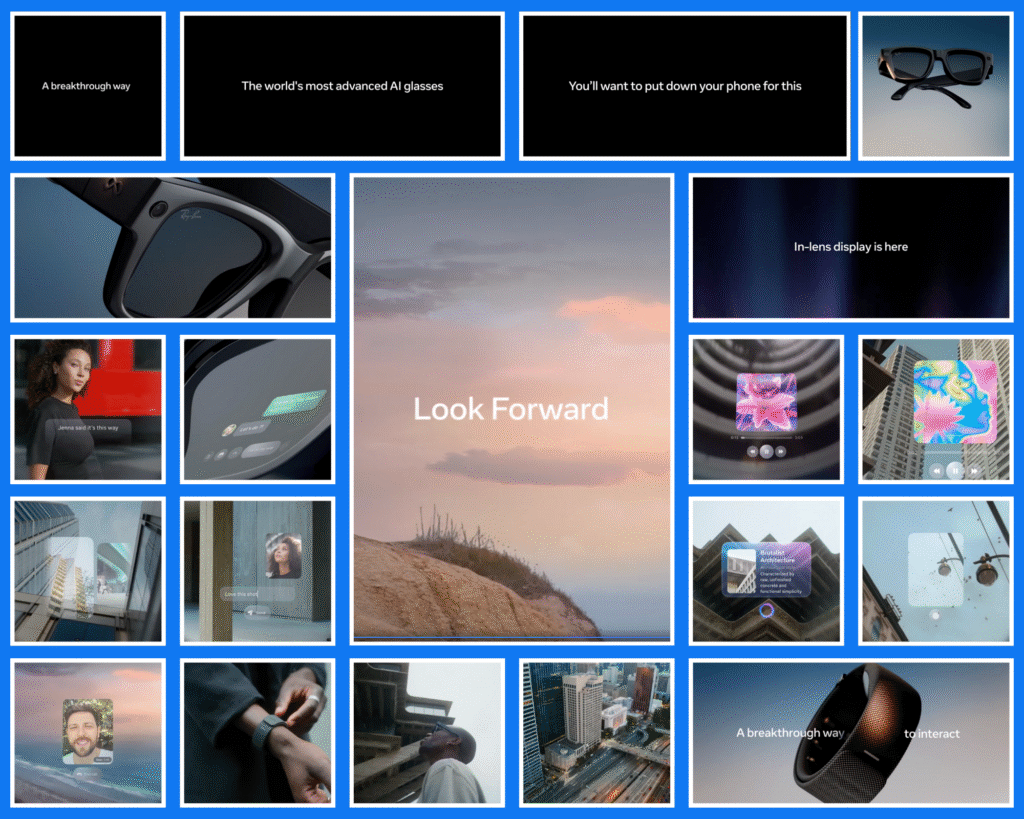
Part 1: How Meta Accidentally Built the World’s Most Important Assistive Technology
The corporate metaverse may have face-planted spectacularly, but Meta’s eyewear empire is having rather a moment—with 2 million units sold of what might be the most transformative assistive technology since screen readers, hidden behind Ray-Ban aviators.
The plot twist nobody saw coming: Meta has accidentally created the world’s most sophisticated accessibility device whilst marketing it as a lifestyle gadget. For 1.4 billion people with disabilities globally, these aren’t just smart glasses—they’re independence machines wrapped in Italian design sensibility.
“When your product can literally change someone’s life by reading signs aloud or captioning conversations, perhaps lead with that rather than the ability to livestream your morning coffee.”
The Hidden Revolution: Accessibility as Killer App
Whilst tech journalists obsess over battery life and fashion partnerships, the real story is unfolding in accessibility communities where Meta’s smart glasses are quietly revolutionising daily life for millions of users. The Ray-Ban Meta glasses don’t just offer “smart features”—they provide transformative independence for people who’ve been waiting decades for this technology.
For Users with Visual Impairments: The Game Changer
Object and scene recognition through Meta AI provides detailed, spoken descriptions of surroundings via simple voice commands.
“Hey Meta, what am I looking at?” becomes environmental awareness on demand—from identifying currency denominations to describing facial expressions during conversations.
Reading assistance transforms any printed material into audio content. Signs, menus, documents, medication labels—all become accessible through AI-powered text recognition that works in real-time without requiring perfect lighting or positioning.
Be My Eyes integration connects users to sighted volunteers globally through the glasses’ camera system, enabling real-time assistance for complex tasks like navigating unfamiliar spaces or identifying specific products whilst shopping.
Prescription lens compatibility means users requiring vision correction can access smart features without compromising their existing optical needs—a crucial consideration often overlooked by pure tech companies.
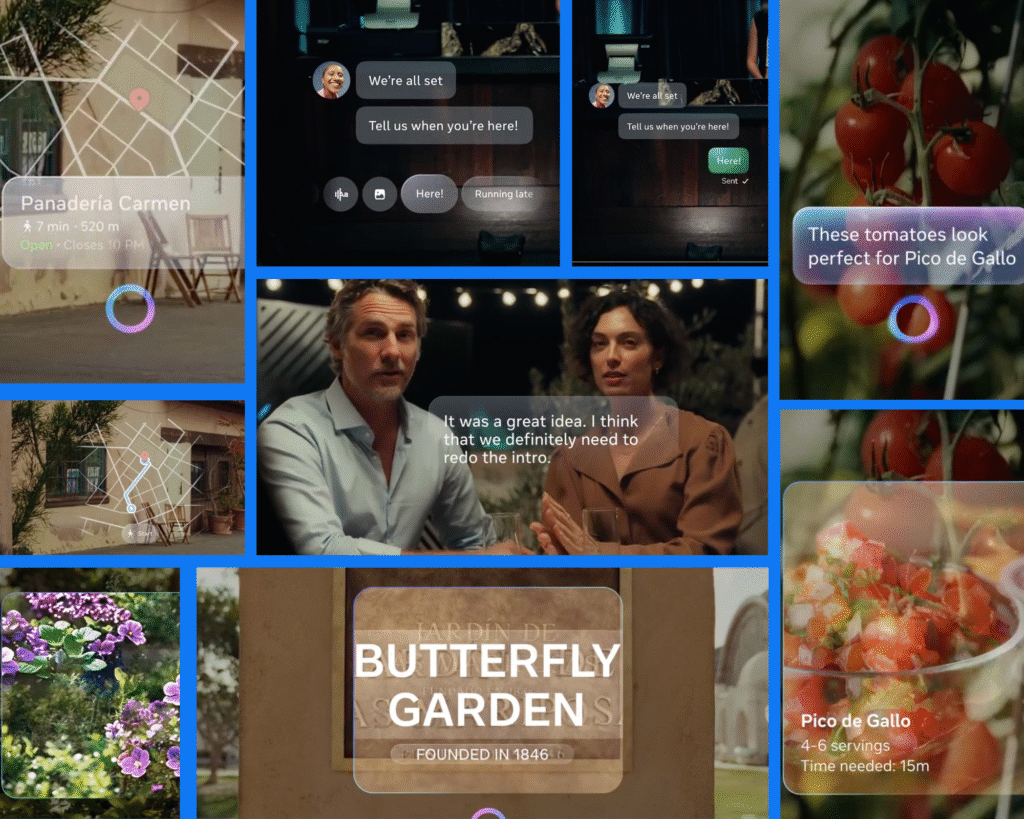
For Users with Mobility Challenges: Hands-Free Liberation
Voice-activated controls eliminate the need for physical device manipulation. Taking photos, making calls, sending messages, and controlling smart home devices become completely hands-free experiences that integrate seamlessly into daily routines.
Video calling functionality allows users to share their point of view with family, caregivers, or support networks on Messenger and WhatsApp without requiring hand coordination or device positioning—revolutionary for users with limited dexterity.
For Users with Hearing Impairments: Visual Communication Enhancement
The Ray-Ban Display variant’s live captioning represents perhaps the most significant advancement in hearing accessibility since cochlear implants. Conversations appear as real-time text directly in the user’s field of vision, eliminating the need to look away from speakers or miss contextual information.
Real-time translation with visual overlay breaks down language barriers whilst maintaining eye contact and social engagement—crucial for professional and personal interactions where traditional translation methods prove disruptive.
Five-microphone array technology reduces background noise during phone calls, making audio communication clearer for users with partial hearing loss whilst providing visual backup through integrated captioning systems.
“This isn’t incremental improvement—it’s the democratisation of assistive technology that previously required expensive, specialised devices with limited aesthetic appeal.”
The Market Opportunity Meta Keeps Ignoring
The Numbers Don’t Lie
Global disability market statistics paint a compelling picture:
- 285 million people with vision impairments globally
- 466 million people with hearing impairments
- Hundreds of millions requiring hands-free interfaces due to mobility challenges
- Over 1 billion people who could benefit from some form of assistive technology integration
Traditional assistive technology companies focus on medical devices with limited aesthetic appeal and premium pricing. Meta’s approach integrates disability support into fashionable consumer products, potentially expanding market reach whilst reducing stigma associated with “medical” devices.
The Competitive Advantage Nobody Recognises
Inclusive design philosophy means accessibility features benefit everyone, not just disabled users. Voice commands prove useful when hands are occupied. Live captioning helps in noisy environments. Real-time translation assists international travel. Universal design principles create broader appeal whilst serving critical accessibility needs.
Fashion-first positioning through Ray-Ban partnerships addresses the psychological barrier many disabled users face with obviously assistive devices. These glasses look indistinguishable from regular Ray-Ban frames, eliminating the social signalling that often accompanies traditional accessibility tools.
Consumer pricing at ₹29,900-35,700 for Gen 2 models makes advanced assistive technology accessible to middle-class consumers globally, rather than requiring specialised funding or insurance coverage typical of medical devices.
Ray-Ban Meta Gen 2: The Foundation (Launching India Autumn 2025)
₹29,900 starting price positions advanced assistive technology at consumer electronics pricing rather than medical device premium. Eight hours of battery life supports full-day independence without charging anxiety that limits traditional assistive devices.
Updated Global Timeline:
- India: Gen 2 arriving autumn 2025, priced from ₹29,900
- Mexico and Brazil: Expected later in 2025
- China: Not supported due to Meta’s limited services presence
Accessibility Features:
- Voice-activated Meta AI with contextual understanding
- Environmental description through computer vision
- Text reading from signs, documents, packaging
- Hands-free photography and communication
- Prescription lens compatibility maintaining vision correction
Technical Specifications:
- Battery: 8 hours mixed use (doubled from Gen 1)
- Video: 3K recording at 60fps with stabilisation
- Audio: Enhanced directional speakers with environmental awareness
- Charging: 50% in 20 minutes, 48-hour case capacity
Oakley Meta: Athletic Accessibility (India Autumn 2025)
$399-499 pricing addresses active lifestyle accessibility needs where traditional assistive devices prove impractical during sports and outdoor activities.
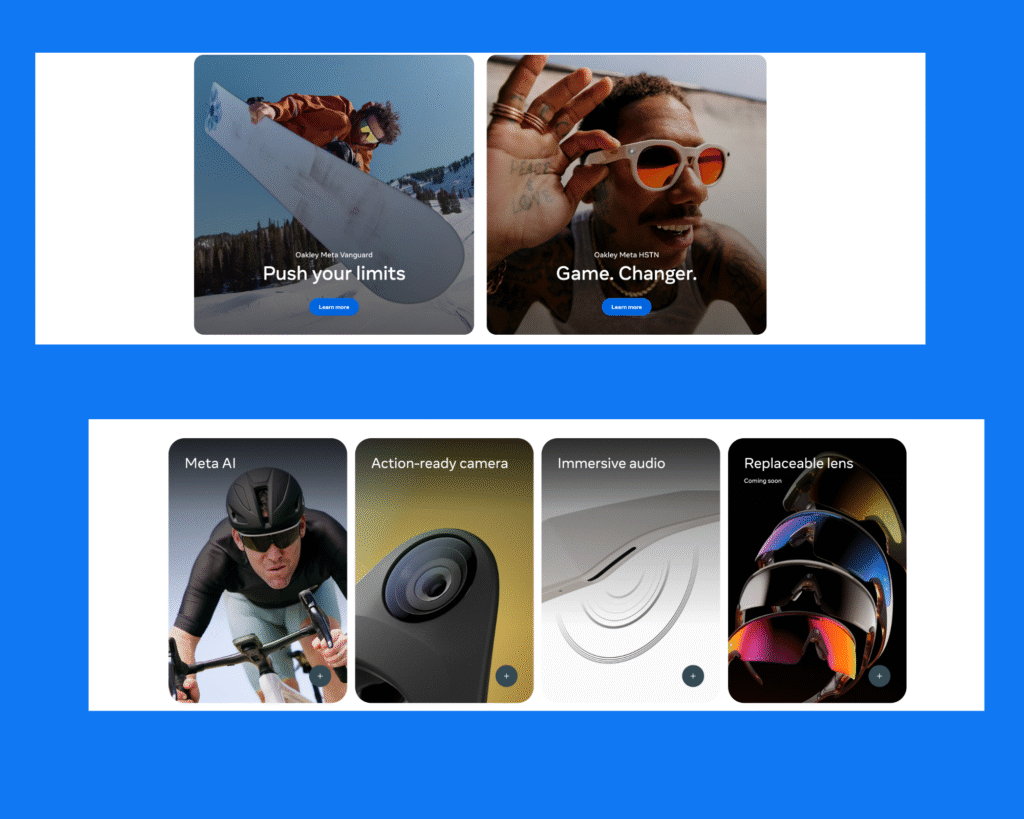
Updated Launch Schedule:
- US and Europe: Pre-orders began September 2025, launching October 21
- Mexico and UAE: Expected later in 2025
- India: Oakley Meta Vanguard arriving autumn 2025
Athletic Accessibility Applications:
- Hands-free coaching through audio guidance systems
- Performance data overlay for users with visual impairments in adaptive sports
- Emergency communication during solo activities for users with mobility challenges
- Environmental hazard identification for outdoor navigation
Sports-specific benefits include secure wraparound fit that accommodates hearing aids, impact resistance for contact sports, and extended battery life supporting day-long outdoor activities.
Ray-Ban Display: The Premium Accessibility Revolution (India 2026)
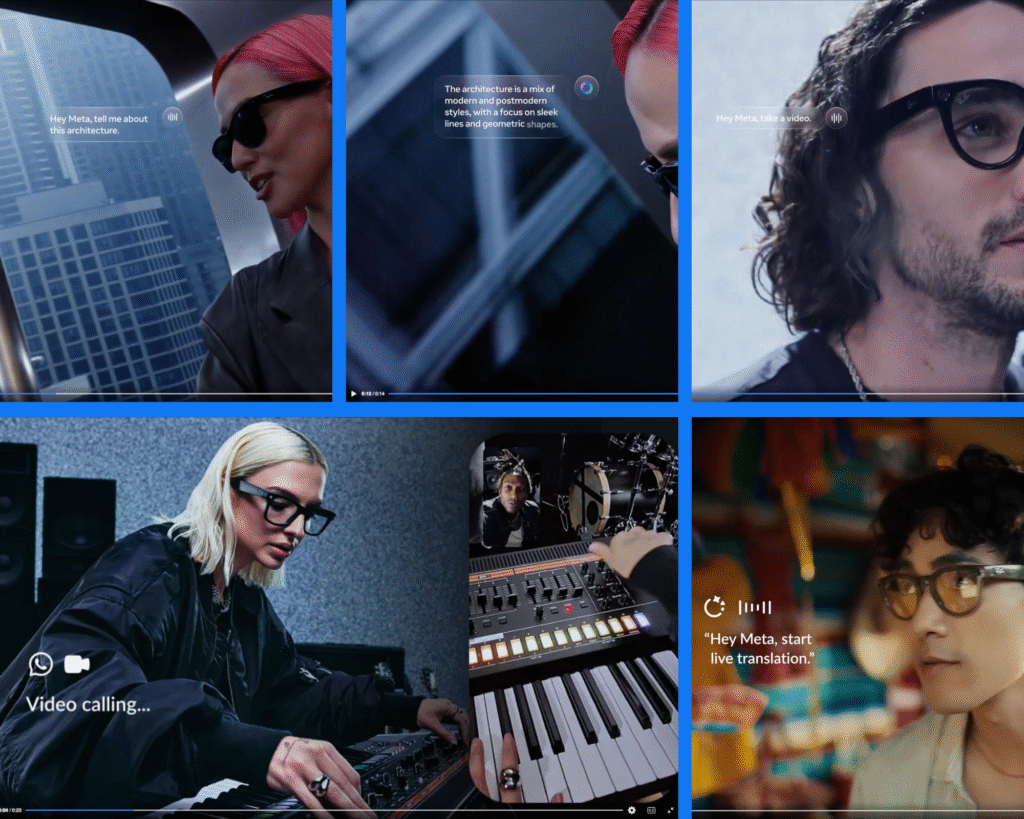
$799 pricing reflects revolutionary assistive technology capabilities rather than lifestyle gadget positioning. Global rollout reality shows Meta’s priorities:
- US launch: September 30, 2025
- Wider global rollout: Early 2026 planned
- India availability: Not scheduled for 2025, global rollout expected 2026
- Some regions: May wait longer than 2026
Revolutionary Accessibility Features:
- Live captioning display: Conversations appear as text directly in user’s field of vision
- Real-time translation overlay: Foreign language text and speech translated instantaneously
- Contextual information display: Object identification and environmental details shown visually
- Neural Band integration: EMG technology enabling complete hands-free control
- Meta AI visual responses: Complex queries answered through combined audio and visual output
Technical Innovation:
- Monocular display: 600×600 pixels at 5,000 nits brightness in right lens
- Six-hour battery life with 24 hours from charging case
- IPX4 water resistance for daily use reliability
- Transition lenses automatically adjusting to lighting conditions
The Channel Strategy: Fashion Meets Function
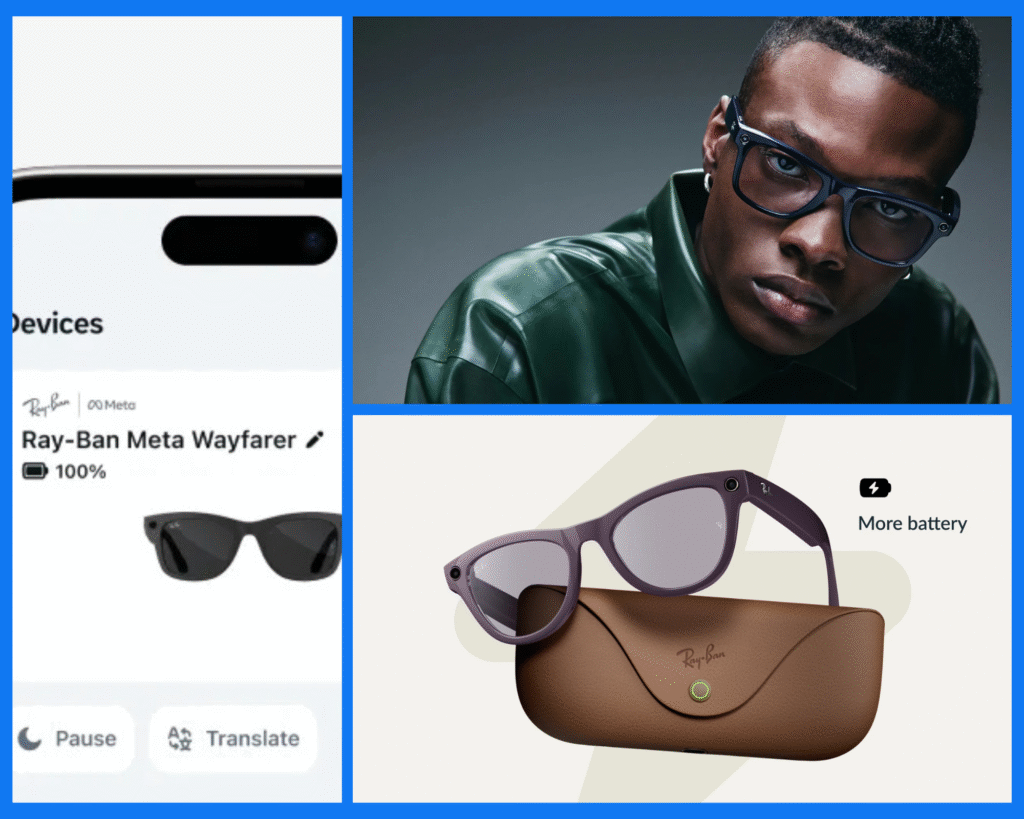
EssilorLuxottica Partnership: Accessibility Without Stigma
Fashion credibility addresses the fundamental challenge facing assistive technology adoption: social acceptance. Traditional accessibility devices often signal disability status, creating psychological barriers to adoption even when functionality proves beneficial.
Partnership Benefits:
- Retail distribution through established eyewear channels worldwide
- Aesthetic credibility that reduces assistive technology stigma
- Manufacturing expertise ensuring comfort during extended wear
- Local market access through existing customer relationships
- Professional fitting services crucial for users requiring precise adjustments
Distribution Performance:
- 2+ million units sold across all variants since launch
- Multiple retail touchpoints including Sunglass Hut, LensCrafters, Titan Eye+
- Fashion retail integration positioning as lifestyle rather than medical devices
India Strategy: Volume Through Accessibility
Titan Eye+ partnership demonstrates strategic understanding of local market requirements whilst potentially missing enormous accessibility opportunity. India’s disability statistics suggest massive underserved market:
- 26.8 million people with disabilities according to 2011 census
- Significant urban middle class growth creating purchasing power
- English language prevalence reducing localisation barriers
- Technology enthusiasm particularly among younger demographics
However, restricting Display features until 2026 creates expectation gaps that could damage brand trust amongst users who need these accessibility features most.
The Competition Nobody’s Watching
Traditional Assistive Technology Market
Established players like OrCam, Envision, and SeeingAI focus on purpose-built accessibility devices with limited aesthetic appeal and premium pricing. Meta’s approach integrates similar functionality into mainstream consumer products, potentially disrupting entire assistive technology sector.
Competitive Advantages:
- Fashion appeal reduces stigma associated with disability devices
- Consumer pricing versus medical device premiums
- Mainstream retail rather than specialised medical supply chains
- Continuous updates through software rather than hardware replacement cycles
Tech Giants Missing the Opportunity
Apple, Google, and Amazon invest heavily in accessibility features but treat them as compliance requirements rather than market opportunities. Meta’s accidental accessibility leadership creates sustainable differentiation that competitors would struggle to replicate quickly.
Apple’s Rumoured 2026 Smart Glasses:
- Ecosystem integration advantages with iPhone, Mac, Apple Watch
- Privacy reputation contrasting with Meta’s history
- Premium pricing likely excluding cost-sensitive accessibility users
- Developer ecosystem proven for iOS applications
Google’s Glass Revival:
- Search integration natural fit for contextual information
- AI language models potentially superior for translation
- Previous failure creates uncertainty about long-term commitment
- Enterprise focus may miss consumer accessibility opportunity
The Global Accessibility Divide
Regional Availability: Disability Discrimination?
Display glasses restriction to Western markets initially excludes regions with enormous disability populations who could most benefit from accessible pricing and features.
This creates uncomfortable questions about accessibility equity in global technology distribution.
India Market Exclusion Impact:
- 26.8 million disabled Indians wait additional 18 months for premium accessibility features
- Regional resentment building among disability advocacy communities
- Alternative brand preferences developing during exclusion period
- Regulatory explanation insufficient for affected users
Global Disability Population Distribution:
- 80% of disabled people live in developing countries
- Lower average incomes make accessibility technology less accessible
- Limited healthcare infrastructure reduces traditional assistive device availability
- Technology enthusiasm high despite economic constraints
Regulatory Complexity vs Accessibility Rights

Compliance-first approach prioritises legal convenience over accessibility equity. Successful global brands typically find ways to maintain feature parity whilst addressing local requirements rather than excluding entire markets from transformative technology.
Alternative Approach:
- Accessibility exception advocacy with regulators
- Humanitarian use case positioning for faster approval
- Local partnership development for compliance navigation
- Phased feature introduction rather than complete exclusion
The Marketing Malpractice: Burying the Lead

Lifestyle Over Life-Changing
Current marketing emphasis on entertainment, social sharing, and lifestyle applications fundamentally misses the value proposition that could create emotional brand connection and justify premium pricing.
Marketing Priority Reversal Needed:
- Lead with accessibility transformation rather than lifestyle convenience
- Feature disability advocates as primary spokespeople rather than tech influencers
- Partner with accessibility organisations for authentic testimonials
- Document real-world impact on daily independence and quality of life
The Emotional Brand Connection Meta’s Missing
Assistive technology users develop fierce brand loyalty when products genuinely improve independence and quality of life. Meta’s current positioning treats accessibility as afterthought rather than primary value driver.
Brand Connection Opportunities:
- Life transformation stories more compelling than tech specifications
- Independence documentation showing real daily impact
- Community building around accessibility innovation
- Advocacy partnership demonstrating genuine commitment to disability rights
“When your product can restore someone’s ability to read restaurant menus independently, perhaps that’s more compelling than showing another influencer taking selfies.”
Strategic Recommendations: Accessibility First
Product Development Priorities
Accessibility-driven roadmap should prioritise features benefiting disabled users rather than adding lifestyle conveniences that don’t address core functionality gaps.
Immediate Focus:
- All-day battery life enabling consistent accessibility support
- Simplified setup reducing technical barriers for older or less tech-savvy users
- Reliability improvements ensuring accessibility features work consistently
- Comfort optimisation for extended daily wear
Market Development Revolution
Accessibility market leadership requires fundamental approach change from technology company to life-enhancement platform serving critical human needs.
Strategic Pivot:
- Healthcare partnership development for professional endorsement
- Insurance coverage exploration positioning as medical necessity
- Disability advocacy collaboration for authentic community engagement
- Research partnership with assistive technology institutions
Communication Strategy Overhaul
Marketing message hierarchy should position accessibility transformation as primary value proposition with lifestyle features as additional benefits.
New Messaging Framework:
- Independence restoration as core promise
- Quality of life improvement as measurable outcome
- Community impact through disability advocacy partnerships
- Technology advancement in service of human dignity
The Accessibility Advantage: Meta’s Hidden Moat
Meta’s smart glasses represent accidental breakthrough in accessibility technology that creates sustainable competitive advantage through genuine human impact rather than technical specifications alone. The company that recognises this positioning first will own the most emotionally resonant value proposition in consumer electronics.
The accessibility market opportunity represents not just revenue potential but brand differentiation that transcends price competition whilst serving critical human needs. Meta’s current approach treats this as compliance afterthought rather than competitive breakthrough.
What comes next depends on whether Meta recognises the revolution they’ve accidentally created—or whether competitors capitalise on the accessibility opportunity Meta keeps ignoring.
Next: Part 2 examines why Meta’s marketing execution undermines their accessibility breakthrough through corporate communication failures and authentic engagement gaps.
Continue reading: Part 2: Why Meta’s Marketing Betrays Their Accessibility Revolution
Sources:
[124] Dayal Opticals India. (2025). Ray-Ban Meta Smart Glasses Launch in India
[128] Times of India. (2025). Titan Eye+ launches Ray-Ban Meta AI smart glasses in India
[131] Ray-Ban India. (2025). Ray-Ban® Official Store India
